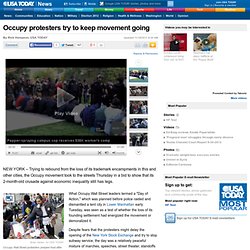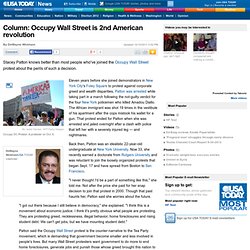

Gingrich: 'Go get a job right after you take a bath' Opinon Journal Live: Occupy Wall Streeters Wear Out Their Welcome. Occupy Wall Street Protests Cost Cities Millions. <br/><a href=" US News</a> | <a href=" Business News</a> Copy It's unclear what the Occupy protests have accomplished, but police have received a bonanza of overtime, making up a large part of at least $10.3 million in costs incurred by nine cities since the protesters began gathering near Wall Street two months ago.

Occupy Wall Street catalyzed dozens, if not hundreds, of protests across the world. New York City alone has spent about $6 million on costs related to Occupy Wall Street, not including the eviction on Tuesday, according to Howard Wolfson, the mayor's deputy for government relations. Philadelphia racked up $492,000 in unanticipated police overtime through last week, according to Rebecca Rhynhart, budget director. "It's an unanticipated expense but we're managing it," Rhynhart said. Oakland spent over $1 million to pay police overtime, according to the Washington Post. In Seattle, protests will cost $625,999 from the week that ended in Oct. 14 to the end of Nov. 25. Occupy Wall Street’s Day Off Message. Occupy Wall Street began with a simple idea: occupy Wall Street.

By sitting, camping, sleeping at what many Americans still see as the symbolic scene of the crimes–both moral and legal–that led to the 2008 financial collapse, the message was clear. It was an act of civil disobedience that pointed the finger at the rich guys in suits. The permanence of the encampment also provided a physical rallying point, so that others could join the movement. As such, the original idea for Occupy can be judged as among the most elegant protests in recent years, the kind of thing that Steve Jobs could love for its simplicity.
Its methods were its message. Now compare the original idea with what happened this week. (PHOTOS: Occupy Protesters March on Manhattan) Occupy Wall Street's future - Videos. Occupy protesters try to keep movement going. NEW YORK – Trying to rebound from the loss of its trademark encampments in this and other cities, the Occupy movement took to the streets Thursday in a bid to show that its 2-month-old crusade against economic inequality still has legs.

What Occupy Wall Street leaders termed a "Day of Action," which was planned before police raided and dismantled a tent city in Lower Manhattan early Tuesday, was seen as a test of whether the loss of its founding settlement had energized the movement or demoralized it. Despite fears that the protesters might delay the opening of the New York Stock Exchange and try to stop subway service, the day was a relatively peaceful mixture of marches, speeches, street theater, standoffs with police and attempts to proselytize passersby at subway stations. Thursday evening, about a thousand people walked peacefully and legally across the Brooklyn Bridge, staying on the walkway under the eye of hundreds of police officers. They weren't the only ones frustrated. Editorial: 5 reasons to protest Wall Street. Column: Occupy Wall Street, a 2nd revolution. Stacey Patton knows better than most people who've joined the Occupy Wall Street protest about the perils of such a decision.

Eleven years before she joined demonstrators in New York City's Foley Square to protest against corporate greed and wealth disparities, Patton was arrested while taking part in a march following the not-guilty verdict for the four New York policemen who killed Amadou Diallo. The African immigrant was shot 19 times in the vestibule of his apartment after the cops mistook his wallet for a gun. That protest ended for Patton when she was arrested and jailed overnight after a clash with police that left her with a severely injured leg — and nightmares.
Back then, Patton was an idealistic 22-year-old undergraduate at New York University. Now 33, she recently earned a doctorate from Rutgers University and was reluctant to join the loosely organized protests that began Sept. 17 and have spread from Boston to San Francisco. DeWayne Wickham writes on Tuesdays for USA TODAY. Occupy Wall Street. Occupy Wall Street (OWS) is the name given to a protest movement that began on September 17, 2011, in Zuccotti Park, located in New York City's Wall Street financial district.

The Canadian, anti-consumerist, pro-environment group/magazine, Adbusters initiated the call for a protest. The ensuing series of events helped lead to media awareness that inspired Occupy protests and movements around the world. In awarding Workhouse its Platinum Award, industry publication PRNews noted "The results, obviously, have been spectacular. There’s hardly a newspaper, Internet or broadcast media outlet that hasn’t covered OWS. The protesters were forced out of Zuccotti Park on November 15, 2011. On December 29, 2012, Naomi Wolf of The Guardian newspaper provided U.S. government documents which revealed that the FBI and DHS had monitored Occupy Wall Street through its Joint Terrorism Task Force, despite labelling it a peaceful movement.[9] Origins[edit] Overview[edit] "We are the 99%"[edit] Goals[edit]